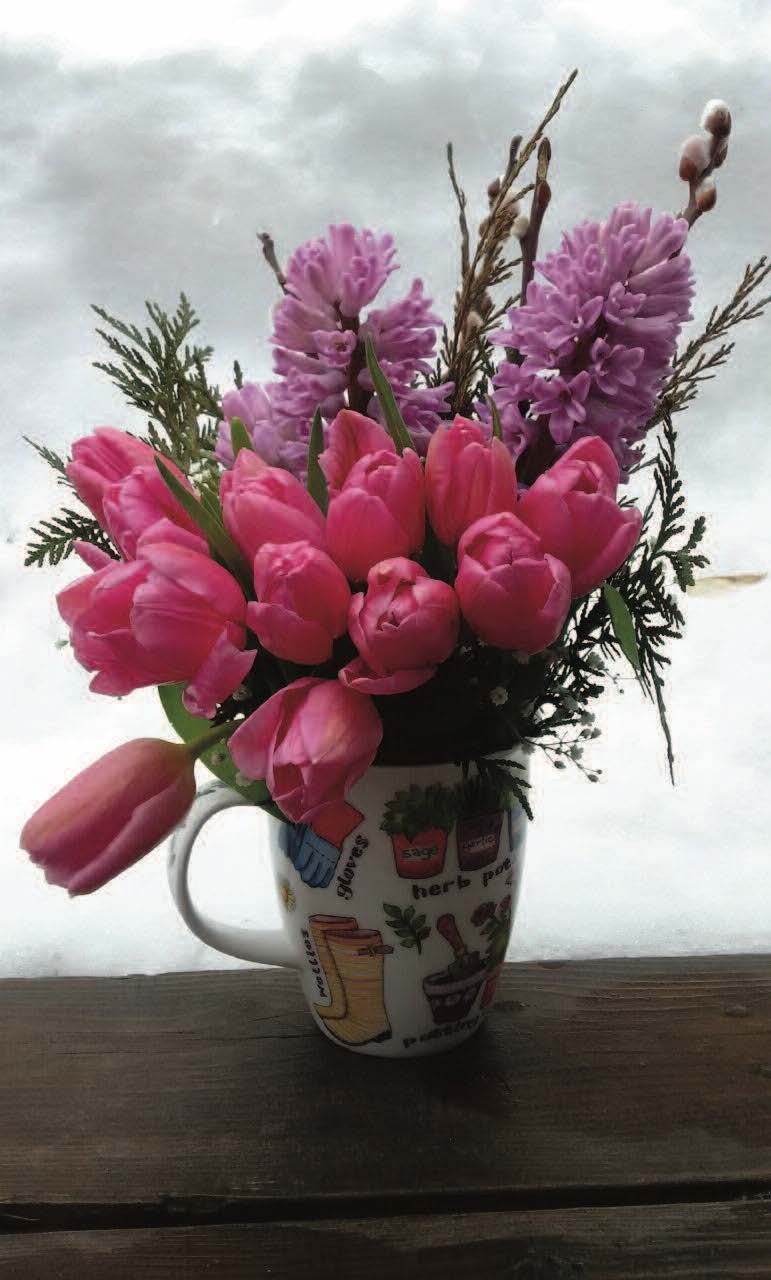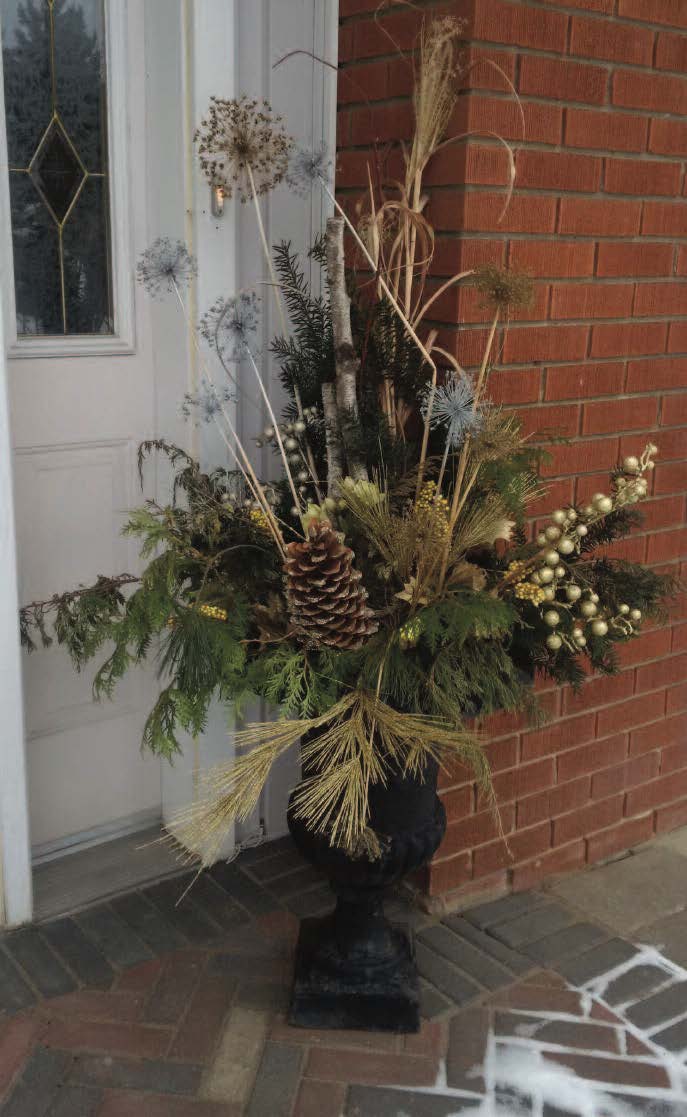
PHOTO: CANDACE DRESSLER
Keep your arrangements looking fresh and seasonal
By Candace Dressler | July/August 2019
One of the best parts of having a garden is being able to enjoy flowers inside as well as out. Planting a blend of annual and perennial flowers allows you to bring the beauty and fragrance of your garden into your home.
Flowers are only part of an arrangement — using branches from shrubs and trees can give your arrangements more structure. Greenery fills them out and hides the mechanics of the arrangement. Sometimes an arrangement can be made with only foliage — a vase of pussy willows is the first introduction of spring in the house. Cut the branches as early as mid-January, put them in a vase of water and they will provide beautiful catkins starting mid-February. Another spring favourite is forsythia branches — the bright yellow flowers always make me smile and one in a tall vase is all you need to make a statement on a hall table.
Spring
The first flowers to come up in the garden are the early irises and bulbs. Plant enough bulbs so you can cut some and enjoy the rest in the garden. Plant different types making sure you have early, mid-season and late flowering bulbs. In Ontario this will give you flowers from the middle of April to late May. Tulips are great cut flowers: just before they open, cut the stem close to the ground, leaving the leaves to regenerate the bulb for next year. Keep these tulips in a tall vase with fresh cool water — they look great alone. Tulips are not the only spring bulbs that are great in vases in the house — narcissus are also wonderful as cut flowers. Treat them the same as tulips, keeping them by themselves. Alliums can be a punctuation point of colour in spring flower arrangements. If you are growing bulbs for cut flowers, plant them 30 centimetres deep and grow a row in a part of your vegetable garden where you are going to plant something shallow-rooted later in the season. As the bulbs are maturing, the flowers finishing and the leaves starting to die back, it is time to plan the annuals for the season. Some seeds can be sown directly in the garden such as sunflowers, sweet peas, cosmos and nasturtiums. Others are best as bedding plants: zinnia, snapdragons, French marigolds. I start summer bulbs such as cannas and dahlias in the house in March to give them a head start.
Summer
As the spring bulbs finish, the lilac bushes, peonies and irises come into full bloom. A vase with two or all three of these flowers will fill your home with wonderful scent and colour.
On July 1, I always cut annual red peony poppies. They self-seed and I also collect seed from them every year. Their bright red flowers are a wonderful way to celebrate Canada Day. I put them with whatever white flowers are showing at the time, such as allium or astilbe, and a few interesting branches such as red dogwood or corkscrew hazel.
As July progresses, I cut sweet peas, calendula and other annuals for arrangements. These blossoms, along with foliage, a branch of yew or euonymus create arrangements with depth. I even bring in daylilies, picking stems with several ready buds.
Late Summer
In August the dahlias start to bloom and I can’t keep up. They are truly the best garden flowers for cutting; well worth the effort of bringing the tubers inside for the winter. Dahlias come in many different shapes and colours and have strong stems. They are stunning as a solitary bloom or in a large arrangement. I have to cut flowers every two days to keep up with the deadheading needed to keep them blooming until October. For arranging, I put them with different foliage to show the changing seasons. A plume of sea kale (Crambe cordifolia) is a great backdrop to show a couple of bright pink blooms. A rhododendron branch will provide good foliage for two months; keeping an arrangement looking fresh can be as simple as changing a single flower in the vase weekly.

PHOTO: CANDACE DRESSLER
Fall
As fall approaches the garden mums put on a fabulous show; in my garden, they bloom from the end of August until the hardest frost. They come in a full variety of colours (pink, lavender, red, gold, rust, yellow). Mums will come back for years when you buy “garden” mums suitable for your zone rather than just planting the “pot” mums from the florist. Other fall plants that are suitable for cutting are echinacea, sedum, hydrangea, and asters. Combine these with fall foliage colours from red dogwood, maple, hazel nut, oak, cotinus, serviceberry, witch hazel or burning bush.
Winter
As the season winds down and plants start to go into dormancy, it is time to prune the evergreen shrubs. Wait until after first frost so you can make a showy arrangement for your front door. I use yew, cedar, juniper, pine and spruce boughs to make a base for a large arrangement in a one-gallon pot. I add some dried flowers I have saved from earlier in the year such as allium, hydrangea or sedum, with some holiday bling and solar light strings.
Conditioning cut flowers
When bringing branches indoors, make sure you either cut a neat x in the bottom or smash the bottom centimeter with a hammer to help the branches take up the water. Re-cut and treat branches with a fresh x cut every couple of weeks to keep them longer.
Tulips will stand taller if you add a teaspoon of cornstarch to the water.
Dahlias and poppies will last longer if you seal the stems by dipping them in scalding water or hold them over a candle flame before you arrange them.
Daylilies and other hollow stemmed plants benefit from a piece of cotton ball in the bottom of the stem, it helps the flowers draw water in.
Candace Dressler has been gardening for 30-ish years. She is a director of the Ontario Horticultural Association and volunteers with Master Gardeners of Ottawa Carleton. She can be found smelling the flowers in her garden.






